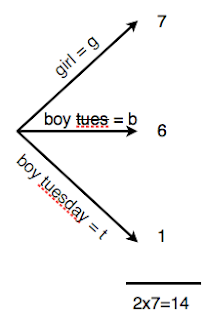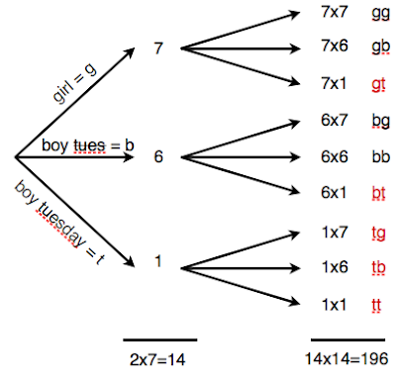Just a quick one. I saw this post, When intuition and math probably look wrong, via Ben Goldacre’s mini blog. The problem is set as follows:
I have two children, one of whom is a son born on a Tuesday. What is the probability that I have two boys?
Intuition tells you the answer is 1/2, mathematicians tell you it’s
something else. I’ll leave the answer until the end of the post in case
you want to run off and solve it first. It’s essentially a fancier
version of the Monty Hall
problem.
The Science News
article deals with this just fine so I don’t really want to expand on
it. The only thing I wasn’t too impressed with was their grid
visualisation. It didn’t really make anything any clearer for me. No,
the only way to go is a good old fashioned tree diagram. So I thought
I’d just show how I solve pretty much all probability problems, as
techniques go it’s slow but you always get the right answer - no
intuition required.
The basic approach is to follow all possible scenarios and split the probabilities of all the events. From the information here we split three events. A child is born, it is either a girl (1/2) or a boy (1/2). We care if the boy was born on a Tuesday or not so we’ll add this as a possibility. I like to put everything over a common denominator so we have: girl (7/14), boy not Tuesday (6/14), boy Tuesday (1/14). On the diagram this goes
Now we have another child, everything’s independent so we have the same possibilities on each branch. We just multiply through the probabilities and keep the common denominator to get
We can use this to solve all girl, boy, boy on Tuesday related questions. Given one child is a boy born on a Tuesday we select all final states that satisfy this (highlighted in red). If you add up their numbers this is a total of 27 out of the 196. Of these 27 where there is one boy born on a Tuesday we count the ones where the other child is a boy (b or t). This comes to a total 13 of the final states.
And that’s it. Of the 27 possibilities where one child is a boy born on Tuesday, 13 have another boy, so the answer is 13/27.
Note, if the question had been phrased “My first child was a boy born on Tuesday…” then you see we follow down the bottom branch and the problem returns to the intuitive answer. If this post seems a bit too elementary then I apologise. It just seems like no one ever mentions tree diagrams as a technique, preferring instead to make the problem seem really hard by banging on about Bayes' theorem and conditional probabilities and so on. They’re all in there, just hidden out of view.
I like tree diagrams because setting one up is pretty mechanical and solving the problem just becomes a question of event counting. You certainly don’t need to worry about Bayes' theorem or anything fancy sounding. And once again, no intuition required.
Which is good because my intuition is crap.

